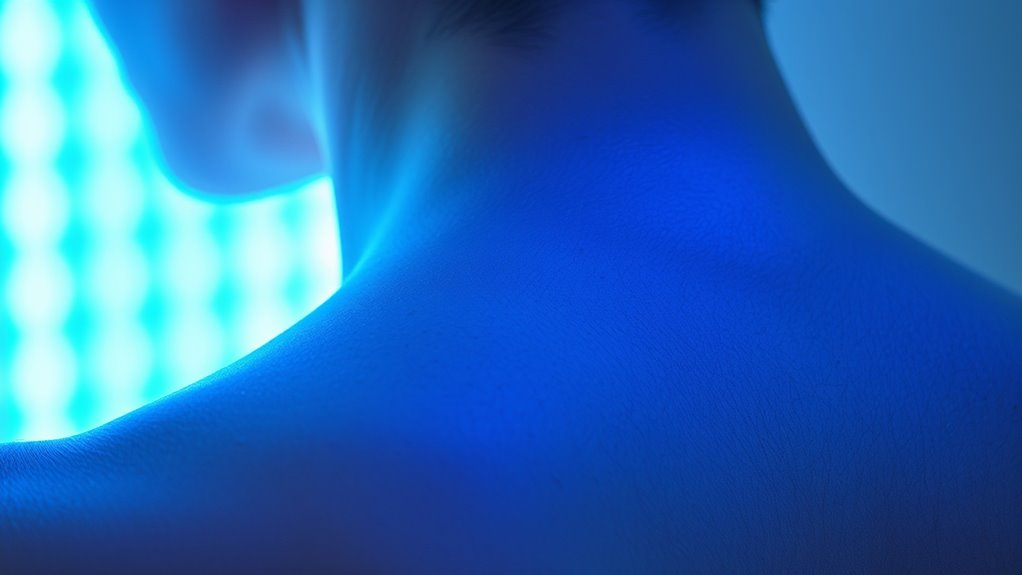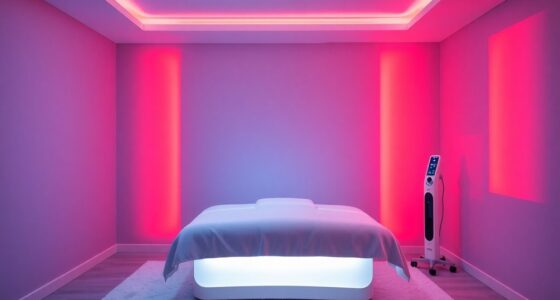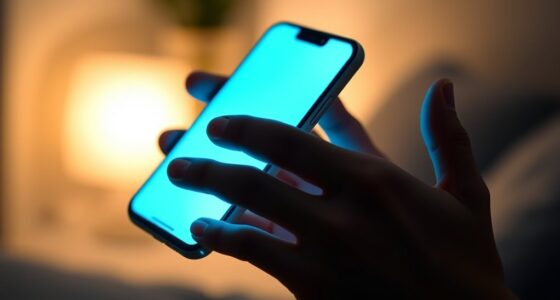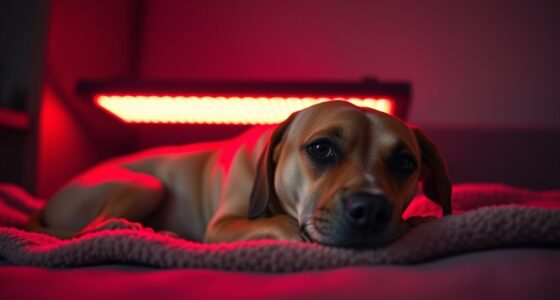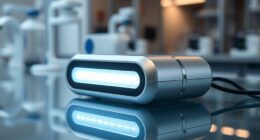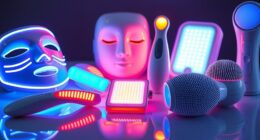To use blue light for back and body breakouts, start by selecting an FDA-approved device like a handheld or mask. Clean your skin thoroughly before each session and follow the manufacturer’s instructions. Position the light a few inches from your skin and keep it steady for 10-15 minutes, several times a week. Consistent use reduces bacteria, inflammation, and breakouts over time. Keep your skin protected afterward with sunscreen—continue exploring for more tips to get the best results.
Key Takeaways
- Choose an FDA-approved blue light device suitable for body use, and follow manufacturer instructions carefully.
- Clean and dry your skin thoroughly before each session for optimal bacterial targeting.
- Position the device a few inches from your back or body area, keeping it steady during treatment.
- Use the device for 10-15 minutes per session, several times weekly, to reduce bacteria and inflammation effectively.
- Protect your skin post-treatment by avoiding direct sunlight and applying broad-spectrum sunscreen daily.

If you’re struggling with back and body breakouts, blue light therapy offers a promising solution. This treatment targets the bacteria responsible for acne, reducing inflammation and preventing new breakouts from forming. Unlike topical creams or oral medications, blue light therapy can be used at home or in a dermatologist’s office, making it a convenient option for many. Before diving in, it’s important to understand how to use blue light safely and effectively to get the best results.
Blue light therapy effectively targets acne-causing bacteria for clearer skin at home or in clinics.
First, choose the right device. There are various blue light devices designed specifically for body acne, including handheld units, masks, or panels. Look for FDA-approved devices to ensure safety and efficacy. Read the instructions carefully, as each device might have different guidelines for use. Most devices recommend starting with sessions of about 10-15 minutes, a few times a week, depending on severity. Consistency is key; regular use helps diminish bacteria and reduces inflammation over time.
Before each session, cleanse your skin thoroughly with a gentle, non-comedogenic cleanser. Removing dirt, oil, and sweat ensures the blue light can penetrate effectively and target the bacteria directly. Make sure your skin is dry before starting the treatment. During the session, position the device according to the manufacturer’s instructions, usually holding it a few inches away from the skin. Avoid pressing too hard or moving the device around excessively; keep it steady to ensure even exposure. If your device has adjustable settings, start with the lowest intensity and gradually increase if comfortable.
While using blue light therapy, avoid exposure to direct sunlight to prevent potential skin sensitivity. Wearing broad-spectrum sunscreen daily helps protect your skin from UV damage and supports healing. Additionally, understanding the role of Artificial Intelligence in Business can help you optimize your skincare routine by utilizing apps or devices that incorporate AI to track your progress and suggest adjustments. Over time, you should notice a reduction in redness, swelling, and the number of active breakouts.
You are trained on data up to October 2023.
Frequently Asked Questions
Can Blue Light Therapy Be Used on Sensitive Skin?
Yes, you can use blue light therapy on sensitive skin, but you should proceed cautiously. Start with a patch test on a small area to check for reactions. Use the device at the lowest setting and follow the manufacturer’s instructions carefully. If you experience redness, irritation, or discomfort, stop use and consult a dermatologist. Blue light therapy can be effective, but sensitive skin needs gentle treatment.
How Often Should I Use Blue Light Treatments?
Think of blue light therapy as watering a garden—you don’t want to overdo it. You should typically use blue light treatments 2-3 times a week, allowing your skin time to recover between sessions. Follow your dermatologist’s advice, and pay attention to how your skin responds. Consistency is key, but moderation prevents irritation. With patience, you’ll see clearer, healthier skin blossom like a well-tended garden.
Are There Any Side Effects From Blue Light Therapy?
Yes, there can be side effects from blue light therapy, but they’re usually mild. You might experience temporary redness, dryness, or irritation on your skin. In rare cases, some people notice eye strain or discomfort if they don’t wear protective eyewear. It’s important to follow the recommended guidelines and consult a dermatologist if you notice persistent or severe side effects. Proper precautions help minimize any risks associated with blue light treatments.
Is Blue Light Effective for Deep or Cystic Acne?
You might think blue light is a silver bullet, but for deep or cystic acne, it’s not the whole story. While blue light can reduce bacteria and inflammation, it often struggles to penetrate deeply enough to target cysts effectively. For stubborn, cystic acne, combining blue light with other treatments like oral medications or corticosteroid injections yields better results. Don’t put all your eggs in one basket—consult a dermatologist for a tailored plan.
Can Blue Light Therapy Replace Medications for Breakouts?
Blue light therapy can help reduce mild to moderate breakouts, but it usually can’t replace medications for severe or cystic acne. If your breakouts are persistent or cystic, you should consult a dermatologist to explore an all-encompassing treatment plan. While blue light is a helpful tool, combining it with prescribed medications often yields the best results. Don’t rely solely on blue light if your acne is severe.
Conclusion
Now that you know how blue light can target stubborn breakouts on your back and body, you might wonder what’s next. Could this simple treatment hold the key to clearer skin, or are there hidden risks you haven’t uncovered yet? Stay tuned—there’s more to discover about revealing your skin’s potential. The journey to breakout-free skin isn’t over, and the answers might surprise you. Are you ready to take the next step?
